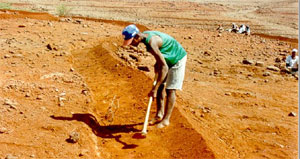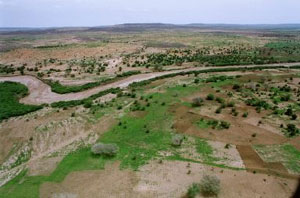Tiempo Climate Cyberlibrary
Desertification and Global Warming:
Common Action for Common Challenges
- Tiempo archive
- Complete issues
- Selected articles
- Cartoons
- Climate treaty
- Latest news
- Secretariat
- National reports
- IPCC
About the Cyberlibrary
The Tiempo Climate Cyberlibrary was developed by Mick Kelly and Sarah Granich on behalf of the Stockholm Environment Institute and the International Institute for Environment and Development, with sponsorship from the Swedish International Development Cooperation Agency.
While every effort is made to ensure that information on this site, and on other sites that are referenced here, is accurate, no liability for loss or damage resulting from use of this information can be accepted.
 |
Staff members of the United Nations Convention to Combat Desertification Secretariat highlight the critical problems and the opportunities that exist in the urgent need to combat desertification. |
|
The United Nations Convention to Combat Desertification in Those Countries Experiencing Serious Drought and/or Desertification, Particularly in Africa is an agreement to combat desertification and mitigate the effects of drought through national action programmes that incorporate long-term strategies supported by international cooperation and partnership arrangements. |
|
For years now, climate change has been recognized as a major environmental issue and one that involves several stakeholders. Consumers, private companies, politicians and researchers are actively engaged in studying the processes of how to reduce emissions and developing innovative policies and mitigation programmes.
The people who may be the most affected by the problem and the ones who will have to adapt are those in the South who live on less than one dollar a day. National Adaptation Programmes of Action are, therefore, being planned and developed in an effort to address this situation. Synergies and the mainstreaming of the issues of climate change with other programmes dealing with development and environment would considerably enhance the efficiency of planned activities.
One of the most alarming processes of global concern, meanwhile, is desertification or land degradation. The recent major report of the Millennium Ecosystem Assessment entitled Ecosystems and Human Well-Being underlines the fact that desertification is one of the greatest environmental challenges and a major impediment to meeting basic human needs in drylands. Desertification is due to direct and indirect human-induced factors, but it is also due to climatic variations, including increasing droughts and flash floods or reduced freshwater availability as a result of global warming.
Desertification is a truly global phenomenon with serious economic and social implications. The urgent need to combat desertification was given recognition by the international community at the 1992 Earth Summit in Rio de Janeiro, Brazil. The United Nations Convention to Combat Desertification (UNCCD) was adopted two years later as an international legally binding instrument to address the issue. Entering into force in 1996, the Convention now counts 191 Parties, the largest membership of the Rio Conventions.
While the intervening years have seen progress in placing desertification on the international agenda, the issue still deserves more recognition. A fact that ought to shake people out of their inertia is the inextricable link between desertification and poverty.
In the Millennium Ecosystem Assessment, desertification was cited as "potentially the most threatening ecosystem change impacting the livelihoods of the poor." Among the two billion people living in drylands, 90 per cent are in developing countries.
Since it is clearly not a one-dimensional environmental issue, the fight against desertification requires a multi-layered approach, which integrates the environmental aspect into a broader socio-economic framework, primarily within the development sphere. The UNCCD stands at the helm of this process, having as its main tool the National Action Programmes to combat desertification, which evaluate the nature and intensity of the problem in the respective country and identify the necessary action to be taken.
|
|
Creating a contour ridge to trap water run-off, Cape Verde © UNCCD |
The link between climate change and desertification is of major significance. According to the Millennium Ecosystem Assessment, dryland soils contain over a quarter of all of the organic carbon stores in the world as well as nearly all inorganic carbon. Due to the increased emissions and reduced carbon sink caused by desertification and related loss of vegetation, it is estimated that about four per cent of total global emissions are generated in drylands. Therefore, restoration and improvement of dryland conditions could have a major impact on global climate change patterns.
Climate change in turn also affects desertification, although the exact links are not sufficiently understood and may vary significantly from one region to another. Due to the increase of energy in the atmosphere, however, it is expected that the number of extreme events such as droughts and heavy rains will increase slightly, potentially having a dramatic impact on already weakened soils. Freshwater availability may also be reduced, due to phenomena such as increased solubility and salt-water intrusions induced by the rise in sea levels.
Some studies go even further. Mike Wallace, co-author of a recently launched study on the shift in jets streams, said that, "if they move another two to three degrees poleward during this century, very dry areas such as the Sahara Desert could nudge further towards the poles, perhaps by a few hundred miles," thereby forcing millions of people either to migrate or to adapt to the changing circumstances.
It is clear, therefore, that synergies between the UNCCD National Action Programmes, which are building bridges between development and environment policies, on the one hand and the United Nations Framework Convention on Climate Change National Adaptation Programmes of Action on the other present a unique opportunity to take a new step towards comprehensive policy instruments. This would allow the development of innovative poverty reduction strategies, while strengthening the adaptation capacities of the poorest and fighting climate change through carbon sequestration and emission reductions.
|
|
Tree planting along crevices caused by floods, Niger © UNCCD |
The United Nations General Assembly designated 2006 the International Year of Deserts and Desertification (IYDD). The IYDD represents a unique opportunity to raise awareness amongst the broadest possible audience and to galvanize policy makers and the public at large into action. It's a chance which must be seized, given the staggeringly sobering statistics that belie the complacency with which the issue of desertification is often treated.
It is also a unique chance to develop synergies with other partners in the context of global change. In other words, collective action as an appropriate response to collective responsibility. This is the only way forward in seeking to put the world firmly on a path of development that is sustainable and to address two of the most important environmental challenges that we face in the 21st century - desertification and climate change.
The international workshop Climate and Land Degradation will be held December 11-15th 2006 in Arusha, Tanzania, as part of the IYDD celebrations. The meeting is organized by the World Meteorological Organisation in collaboration with the UNCCD and will be a great opportunity to move forward.
Further information
External Relations and Public Information Unit, UNCCD
Secretariat, Hermann-Ehlers-Str.10, 53113 Bonn, Germany.
Fax: +49-228-8152899. Email: info@unccd.int. Web: www.unccd.int.
On the Web
A report on the International Year of Deserts and
Desertification is
available in the Tiempo Climate Cyberlibrary. The
Cyberlibrary also maintains a selected list of websites
covering drylands
and desertification.
Bright Ideas

General Electric plans to cut solar installation costs by half

Project 90 by 2030 supports South African school children and managers reduce their carbon footprint through its Club programme

Bath & North East Somerset Council in the United Kingdom has installed smart LED carriageway lighting that automatically adjusts to light and traffic levels

The United States National Oceanic and Atmospheric Administration and the American Public Gardens Association are mounting an educational exhibit at Longwood Gardens showing the link between temperature and planting zones

The energy-efficient Crowne Plaza Copenhagen Towers hotel is powered by renewable and sustainable sources, including integrated solar photovoltaics and guest-powered bicycles
El Hierro, one of the Canary Islands, plans to generate 80 per cent of its energy from renewable sources

The green roof on the Remarkables Primary School in New Zealand reduces stormwater runoff, provides insulation and doubles as an outdoor classroom

The Weather Info for All project aims to roll out up to five thousand automatic weather observation stations throughout Africa

SolSource turns its own waste heat into electricity or stores it in thermal fabrics, harnessing the sun's energy for cooking and electricity for low-income families

The Wave House uses vegetation for its architectural and environmental qualities, and especially in terms of thermal insulation

The Mbale compost-processing plant in Uganda produces cheaper fertilizer and reduces greenhouse gas emissions

At Casa Grande, Frito-Lay has reduced energy consumption by nearly a fifth since 2006 by, amongst other things, installing a heat recovery system to preheat cooking oil
Updated: May 15th 2015

